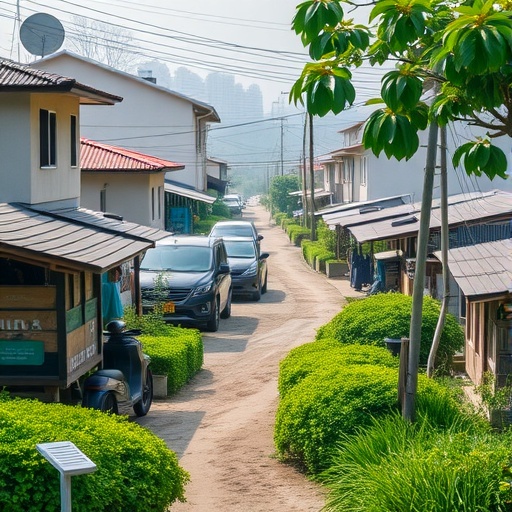In a groundbreaking study that sheds light on the long-term consequences of the COVID-19 pandemic, researchers have uncovered a persistent disparity in mortality rates between rural and urban populations following SARS-CoV-2 infection. This comprehensive analysis, spanning a remarkable two-year period post-infection, reveals that individuals residing in rural areas experience significantly higher mortality compared to their urban counterparts. The findings not only underscore geographical health inequities but also raise compelling questions about the underlying factors driving these differences and their implications for public health strategies moving forward.
The investigation tackled one of the most pressing questions at the heart of pandemic management: does the initial environment of infection influence long-term health outcomes? To explore this, the research team meticulously curated a large cohort from diverse geographical settings, enabling a robust comparison of survival outcomes after SARS-CoV-2 infection. Their study design incorporated extensive follow-up periods, clinical data, and sociodemographic variables to ensure a comprehensive understanding of the impact of rurality on mortality risk beyond the immediate aftermath of infection.
Through sophisticated epidemiological modeling and survival analysis, it became evident that rural dwellers faced a sustained elevation in mortality risk extending up to 24 months subsequent to their initial COVID-19 diagnosis. This prolonged vulnerability transcends the acute phase of infection, suggesting that factors associated with rural living may perpetuate adverse health trajectories long after the virus has been cleared. These results challenge previous assumptions that urban environments, often characterized by higher population density and transmission rates, would bear the brunt of long-term COVID-19 consequences.
The study offers detailed insights into potential mechanisms underpinning this disparity. Rural populations frequently encounter structural barriers to healthcare access, including limited availability of specialized medical resources and longer travel distances to healthcare facilities. Such constraints might delay diagnosis and treatment of COVID-19 complications or other emergent health conditions exacerbated by SARS-CoV-2 infection. Furthermore, disparities in socioeconomic status, prevalence of comorbidities, and environmental factors could amplify the risk of fatal outcomes in these communities.
Importantly, the researchers highlight the role of healthcare infrastructure as a critical determinant of post-infection survival. In urban centers, comprehensive health systems and greater provider density facilitate prompt intervention and ongoing management of post-COVID complications, potentially mitigating mortality. Conversely, the inadequate healthcare ecosystem in many rural areas may hinder effective continuity of care, allowing subtle but progressive health deteriorations to go unaddressed until they reach a fatal stage.
The implications of these findings are manifold for public health policy, health equity initiatives, and pandemic preparedness. They underscore the urgent need for tailored healthcare delivery models that account for geographic disparities and extend beyond initial infection control. Strengthening rural health systems, expanding telemedicine capabilities, and deploying mobile health units may serve as pivotal strategies to close this mortality gap and ensure equitable health outcomes across urban-rural divides.
Moreover, the persistence of elevated mortality risk over an extended period calls for rethinking post-acute COVID-19 care protocols. Long COVID clinics, currently concentrated in metropolitan areas, should be expanded into rural regions to provide specialized evaluation and management for patients experiencing lingering symptoms or complications. Incorporating multidisciplinary approaches that address physical, mental, and social determinants of health will be critical in enhancing recovery trajectories and reducing premature mortality.
In addition to healthcare delivery, the findings provoke crucial discussions about health data infrastructure and surveillance. Continuous monitoring of COVID-19 outcomes, stratified by geography and socioeconomic variables, is essential to detect evolving patterns and inform targeted interventions. Enhanced data integration from multiple sources, including electronic health records, claims databases, and community health surveys, will facilitate granular analyses and evidence-based decision-making.
The persistence of higher mortality in rural areas despite widespread vaccination and therapeutic advances emphasizes the complexity of post-pandemic recovery. It signals that intrinsic disparities embedded in societal and systemic structures can negate some benefits of medical progress if not addressed holistically. The study therefore advocates for a multifaceted approach that synergizes biomedical, social, and policy interventions to mitigate long-term COVID-19 burdens equitably.
Additionally, behavioral and cultural factors prevalent in rural communities may play a contributory role in shaping health outcomes. Varied perceptions of disease risk, vaccine hesitancy, and differing adherence to public health recommendations might influence exposure levels, disease severity, and subsequent health trajectories. Understanding these sociocultural dynamics is essential for designing effective outreach and education programs tailored to rural populations’ unique characteristics.
Environmental exposures intrinsic to rural settings, such as occupational hazards among agricultural workers or limited access to clean water and sanitation, could also exacerbate vulnerability to post-COVID complications. These chronic stressors may compound immune dysregulation triggered by SARS-CoV-2, thereby increasing susceptibility to mortality. Future research disentangling these complex interplays will be instrumental in devising comprehensive mitigation strategies.
The international ramifications of this research are vast, especially considering that many countries harbor significant rural populations with sparse healthcare resources. It urges global health organizations and national governments to prioritize rural health equity as a cornerstone of pandemic response and recovery frameworks. Lessons gleaned here can inform resource allocation, emergency preparedness, and the design of resilient health systems capable of withstanding and adapting to prolonged health crises.
Finally, the study serves as a clarion call for sustained investment in rural health research and infrastructure beyond the pandemic context. While COVID-19 has spotlighted disparities, similar patterns likely exist for numerous chronic and infectious diseases prevalent in rural settings. Addressing these longstanding inequities will yield dividends in population health, economic stability, and social justice long into the future.
This seminal research adds a vital dimension to our understanding of the heterogeneous impacts of the COVID-19 pandemic, revealing that geography is a potent determinant of survival well beyond the initial viral insult. As the world transitions from pandemic to endemic phases, harnessing these insights to shape equitable health policies and practices will be essential to safeguard vulnerable populations and build healthier, more inclusive societies.
Subject of Research:
Long-term mortality disparities following SARS-CoV-2 infection between rural and urban populations.
Article Title:
Higher mortality following SARS-CoV-2 infection in rural versus urban dwellers persists for two years post-infection.
Article References:
Anzalone, A.J., Vest, M.T., Schissel, M.E. et al. Higher mortality following SARS-CoV-2 infection in rural versus urban dwellers persists for two years post-infection. Nat Commun 16, 8933 (2025). https://doi.org/10.1038/s41467-025-63944-8
Image Credits:
AI Generated
Tags: COVID-19 pandemic impact on rural communitiesepidemiological modeling in rural areasgeographical health inequitiesimplications of rural health researchlong-term COVID-19 mortalitymortality risk analysis after infectionpublic health strategies for rural populationsrural health disparitiesSARS-CoV-2 infection outcomessociodemographic factors in health outcomessurvival analysis of COVID-19 patientsurban vs rural health inequities





